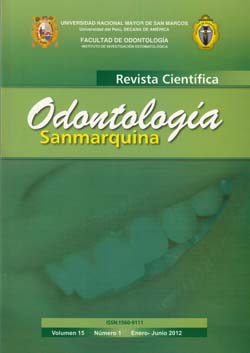Sellado marginal de obturaciones de resina compuesta fotoactivadas con luz L.E.D. y luz halógena
DOI:
https://doi.org/10.15381/os.v15i1.2825Palabras clave:
fotopolimerización, L.E.D, sellado marginalResumen
El objetivo es comparar in vitro el grado de sellado marginal de restauraciones de resina compuesta fotopolimerizadas con luz L.E.D y con luz halógena convencional. Se emplearon 20 molares sanas recientemente extraídas, en cada una de las cuales se realizaron cavidades clase V, una en la superficie vestibular y otra en la superficie palatina de dimensiones estandarizadas. Ambas cavidades fueron obturadas con resina compuesta de nanoparticulas Filteck Z350 y adhesivo Single Bond (3M). Las restauraciones vestibulares se polimerizaron con luz L.E.D., y las palatinas o linguales con luz halógena convencional. Una vez restaurados, los molares se mantuvieron por 48 horas a 37 °C y 100 % de humedad. Las muestras fueron sometidas a un régimen de termociclaje en una solución de azul de metileno al 1 % para posteriormente evaluar el grado de microfiltración marginal del colorante, realizando un corte en sentido vestíbulo palatino o lingual, y evaluando con un microscopio estereoscopio. Los resultados mostraron que la frecuencia de especímenes que presentaron filtración de colorante fue del 85 % para las obturaciones fotoactivadas con luz convencional y del 50 % para las obturaciones fotoactivadas con luz L.E.D, esta diferencia fue estadísticamente significante (p < 0.05). El grado más severo de penetración de colorante en la interfase diente restauración se presentó en el 60 % de las muestras fotoactivadas con luz halógena y en un 15 % de las muestras fotoactivadas con luz L.E.D, esta diferencia resultó estadísticamente significante, (p = 0.004). Bajo las condiciones del presente estudio se llegó a la conclusión que el grado de sellado marginal de obturaciones de resina compuesta fue significativamente mayor con el fotoactivado de luz L.E.D, que con luz halógena convencional.Descargas
Descargas
Publicado
Número
Sección
Licencia
Derechos de autor 2012 Martha Elena Pineda Mejía, Liliana Ángela Terán Casafranca, Waldo Ernesto Gloria Zevallos, Luis Alberto Cuadrao Zavaleta

Esta obra está bajo una licencia internacional Creative Commons Atribución-NoComercial-CompartirIgual 4.0.
LOS AUTORES RETIENEN SUS DERECHOS:
a. Los autores retienen sus derechos de marca y patente, y también sobre cualquier proceso o procedimiento descrito en el artículo.
b. Los autores retienen el derecho de compartir, copiar, distribuir, ejecutar y comunicar públicamente el artículo publicado en la Odontología Sanmarquina (por ejemplo, colocarlo en un repositorio institucional o publicarlo en un libro), con un reconocimiento de su publicación inicial en la revista Odontología Sanmarquina.
c. Los autores retienen el derecho a hacer una posterior publicación de su trabajo, de utilizar el artículo o cualquier parte de aquel (por ejemplo: una compilación de sus trabajos, notas para conferencias, tesis, o para un libro), siempre que indiquen la fuente de publicación (autores del trabajo, revista, volumen, número y fecha).






